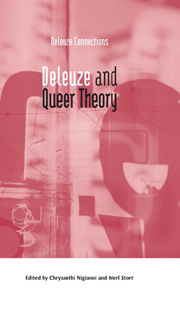Book contents
- Frontmatter
- Contents
- Introduction
- 1 On the Very Possibility of Queer Theory Claire Colebrook
- 2 Thirty-six Thousand Forms of Love: The Queering of Deleuze and Guattari
- 3 The Sexed Subject in-between Deleuze and Butler Anna Hickey-Moody and Mary Lou Rasmussen
- 4 Every ‘One’ – a Crowd, Making Room for the Excluded Middle
- 5 The Adventures of a Sex
- 6 Queer Hybridity
- 7 Prosthetic Performativity: Deleuzian Connections and Queer Corporealities
- 8 Unnatural Alliances
- 9 Schreber and the Penetrated Male
- 10 Butterfly Kiss: The Contagious Kiss of Becoming-Lesbian Chrysanthi Nigianni
- Notes on Contributors
- Index
4 - Every ‘One’ – a Crowd, Making Room for the Excluded Middle
Published online by Cambridge University Press: 12 September 2012
- Frontmatter
- Contents
- Introduction
- 1 On the Very Possibility of Queer Theory Claire Colebrook
- 2 Thirty-six Thousand Forms of Love: The Queering of Deleuze and Guattari
- 3 The Sexed Subject in-between Deleuze and Butler Anna Hickey-Moody and Mary Lou Rasmussen
- 4 Every ‘One’ – a Crowd, Making Room for the Excluded Middle
- 5 The Adventures of a Sex
- 6 Queer Hybridity
- 7 Prosthetic Performativity: Deleuzian Connections and Queer Corporealities
- 8 Unnatural Alliances
- 9 Schreber and the Penetrated Male
- 10 Butterfly Kiss: The Contagious Kiss of Becoming-Lesbian Chrysanthi Nigianni
- Notes on Contributors
- Index
Summary
Do you long for the power of a concept of self? Simply repeat after me, ‘I think, therefore I am’, and all the doubting, thinking and being of the cogito are yours, your persona. Given the multitude of forces at work, each ready to claim sovereignty, we might have to embark on a more hazardous outing, another spin through the world which puts philosophical intuition into play and which recalls us to our finitude in order to construct logics and languages influenced by the unperceived, unknown past that nonetheless inhabits us, like light rays diffracting into spectra.
(Olkowski 2007: 22–3)The Brittlestar and Classical Dynamics
Physicist and philosopher Karen Barad has given us an account of an amazing sea creature, the Brittlestar, an invertebrate related to starfish, a creature that has no eyes, but is all eyes. The approximately ten thousand spherically domed calcite crystals covering the five limbs and central body of the Brittlestar function as microlenses that collect and focus light directly onto nerve bundles which are part of the Brittlestar's diffuse nervous system, giving it compound-eye capability (Barad in press). The Brittlestar's microlenses are optimised to maximise visual acuity enabling them to discern predators or discover hiding places. However, all of this activity takes place in a creative tension between the resolution of detail and diffraction effects and between geometrical and physical optics. Scientists, she notes, are studying the Brittlestar in the hope of mimicking its technique for producing vision. Of special interest is the information that the Brittlestar is a creature without a brain; it is simply a visualising apparatus, a metamorphosing optical system.
- Type
- Chapter
- Information
- Deleuze and Queer Theory , pp. 54 - 71Publisher: Edinburgh University PressPrint publication year: 2009



